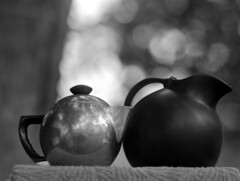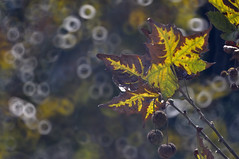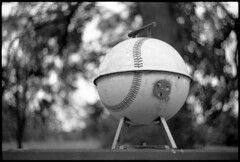Bokeh

|
| Smooth and unobtrusive bokeh (Kodak Anastigmat barrel lens) image by Voxphoto (Image rights) |

|
| Ring-shaped bokeh from a mirror telephoto lens image by Angelo Puglisi (Image rights) |

|
| Swirly bokeh image by Voxphoto (Image rights) |
Bokeh (Japanese "boke" = blur or haze) is how a lens renders the defocused areas of an image.
Blur qualities
The defocused areas of an image can be busy and distractingly patterned; or smooth and "creamy." The effect becomes especially visible when the unsharp background (or foreground) has significant contrasts, as with pinpoints of light appearing against darker surroundings. The term bokeh is used when discussing the subjective quality of the blurred area. Portraiture particularly calls for lenses with pleasant, soft, undisturbing bokeh.
Defocused points of light will show the shape of the the aperture opening, and this can be distracting when noticeably hexagonal or octagonal. However simply redesigning a diaphragm to provide a rounder opening does not guarantee pleasing bokeh[1]. Other factors such as the degree of spherical aberration affect how light is distributed within the blur disk; and a complete optical analysis of bokeh can become quite complicated[2].
When background highlights are rendered with a distinct bright-ring perimeter, generally this will lead to very agitated bokeh. Because the optimum condition for smooth bokeh is a blur disk which brightens towards its center, lenses have been offered with a so-called apodization filter surrounding their aperture stop[3] with a neutral-density gradient to "fade out" the edges of the blur disk.
Lens designers must balance many factors, such as in-focus sharpness, cost, and weight; and in some cases bokeh may be compromised to reach these goals. A lens's bokeh may be particularly jangly at its widest aperture, but considerably smoother when closed down by 1 or 2 f/stops. But a highly patterned background that is only slightly out of focus can give troubling bokeh regardless of the lens design.
Spelling, pronunciation
The final h in bokeh is sometimes omitted; similar Japanese words such as sake do not use it. But when publishing four articles on the topic in the March/April 1997 issue of Photo Techniques, editor Mike Johnston decided that some readers might mistake the word as rhyming with "toke." Adding the final h was intended to suggest the correct pronunciation to English-speakers[4].
There is a trend among English-speakers to pronounce the word "boo-KAY" (perhaps in confusion with "bouquet," as used in connection with wine-tasting). However the Japanese pronunciation is approximately "BO-kuh."
Misuse of term
The word bokeh is sometimes misunderstood to mean a photograph with especially prominent out-of-focus areas, e.g. "a bokeh shot." This confuses the quantity of the blur with its quality. A lens's entrance pupil diameter is the main parameter determining the amount of distant background blur; the specific optical formula has little effect.
References
- ↑ "What's BOKEH, Anyway?" by Rick Oleson.
- ↑ Depth of Field and Bokeh, by Dr. H. H. Nasse (1.7 Mb PDF) from Carl Zeiss Camera Lens News #35
- ↑ An example is the 2014 Fujifilm XF 56mm F1.2 R APD for X-mount mirrorless digital cameras.
- ↑ "Bokeh in Pictures", a Mike Johnston column on Photo.net
Links
- Bokeh Test (scroll down for sample images), by Rick Denny
- Podcast Episode #181 : Bokeh! by Martin Bailey, a photographer bilingual in English and Japanese, discussing the correct pronunciation and the meanings of related Japanese words.